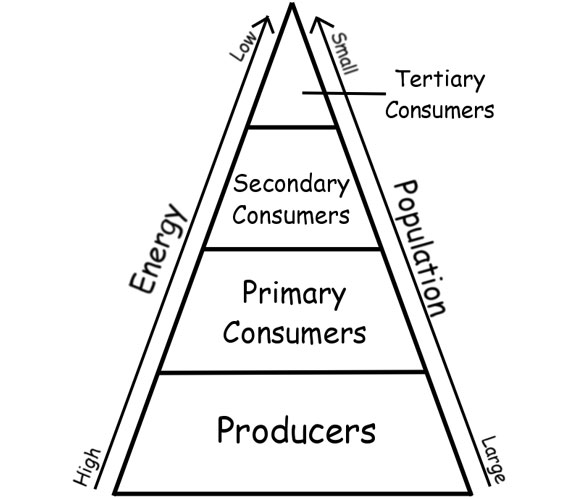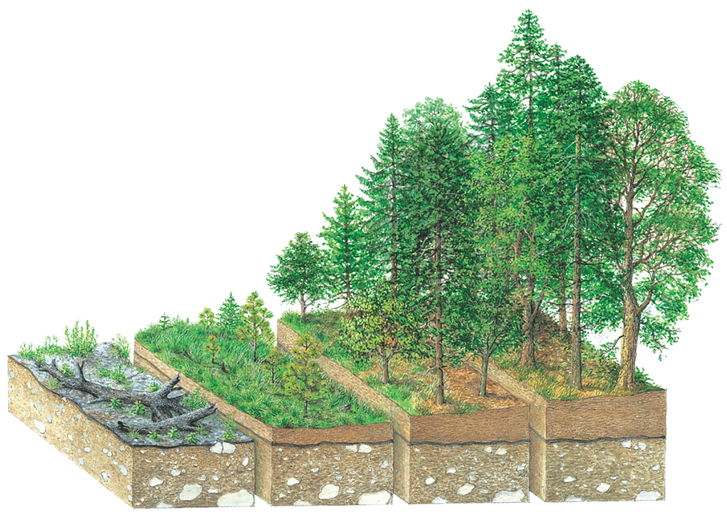|

Birds called anhingas live in swamps and marshes in the southeastern United States and hunt fish and other animals for food.
|
|
Ecology
Ecosystem
- an system of interrelated living and nonliving things.
Biotic factors
- the living things in an ecosystem.
Abiotic factors
- the nonliving things in an ecosystem.
Biodiversity
- the number of different species living in an ecosystem.
Population
- a group of organisms of the same species living in the smae area.
Community
- a group of populations living in the same area.
Ecosystem
- a community and abiotic factors in an area.
Biome
- a large region of the Earth with similar communities and climate.
Biosphere
- all the inhabited regions of the Earth.

http://oceancolor.gsfc.nasa.gov/SeaWiFS/HTML/SeaWiFS.BiosphereAnimation.70W.html
|

Organism --> Population --> Community --> Ecosystem --> Biome --> Biosphere

http://www.emc.maricopa.edu/faculty/farabee/biobk/biobookcommecosys.html
|
|
Questions
What is ecology?
What is an example of an interaction between an organism and a nonliving thing?
What is an example of an interaction between an organism and another organism?
What is the difference between a community and its ecosystem?
What are biotic factors in an ecosystem? Give two examples.
What are abiotic factors in an ecosystem? Give two examples.
Define ecosystem using the words community, population, and abiotic factors.
What is biodiversity?
|
Copy the table below and fill in the characteristics of each biome.

|
|
Relationships in ecosystems
producer
- organisms that get their energy from nonliving sources.
consumer
- organisms that get their energy by eating other organisms.
decomposer
- a consumer that eats dead organisms.
autotroph
- an organism that produces its own food.
heterotroph
- an organsism that uses other organisms for food.
herbivore
- a consumer that eats only producers.
carnivore
- a consumer that eats only animals.
omnivore
- a consumer that eats both producers and animals.
food chain
- feeding relationships from one producer through a series of consumers.
food web
- a complex network of feeding relationships in an ecosystem.
trophic level
- the position of an organism in a food chain.
habitat
- the area where an organisms lives.
niche
- the interactions of an organism with its ecosystem - feeding relationships, effect on abiotic factors, and other behaviors.

|
Producers and Herbivores/Primary Consumers

Carnivore/Secondary Consumer

Decomposers
 

Food Web

- What's missing from this food web?
|
|
Questions
- Where does the initial energy for an ecosystem come from?
- Describe the relationship between producers, consumers, and decomposers.
- Distinguish between autotroph and heterotroph.
- Draw a food chain with named examples of organisms.
- Label the food chain with producer, and consumers (primary, secondary, tertiary, etc).
- Label the food chain with autotroph and heterotroph.
- Label the food chain with herbivore, carnivore, and omnivore.
- Briefly describe an example of a food web.
- Define niche and give an example of an organism's niche.
- Define habitat and give an example of an organism's habitat.
- The food web diagram above has a triangular shape. What do you think the triangular shape signifies.
|
|
|
Energy Pyramid
A diagram that shows the relative amounts of energy in each trophic level.
- The bottom level is the producer level - ot's always teh largest level.
- The next level is the primary consumer level - the herbivores.
- The next level is the secondary consumer level - the carnivores.
- Depending on thekind of ecosystem, the pyramid may have tertiary consumers (3rd) or quaternary consumers (4th) levels.
- Decomposers are usually not shown - they receive energy from all levels of the pyramid.
Trends in an energy pyramid:
- There is less energy in each trophic level moving up the pyramid.
- Energy is lost at each level as heat from cellular respiration and as waste like feces.
- The size of the populations gets smaller moving up the pyramid.
- Biomass also decreases moving up the levels of the pyramid.
- biomass is the dry weight of the carbon-based compounds of all the organisms at a trophic level (the water is removed).
Questions
How many trophic levels are in the pyramid with the owl on top?
What kind of consumer is the primary consumer?
How much energy moves from one trophic level to the next trophic level - look at the diagram and calculate the percentage of energy in kcal's that is available from one level to the next?
How much energy is lost?
Where does it go?
Why is the bottom level of an energy pyramid always producers?
|


("kcal" is a unit of energy)
|
|
Cycles
Matter moves in cycles through ecosystems.
It moves from nonliving things into living things and back to nonliving things in a cycle.
Examples of cycles:
- hydrological cycle (water cycle)
- carbon cycle
- oxygen cycle
- nitrogen cycle
Hydrological Cycle

Carbon cycle

Oxygen cycle

Nitrogen cycle

|
|
Questions
What are three elements that cycle through ecosystems?
Why are they important?
Why are decomposers important for cycles?
How does cutting down trees in a forest affect the oxygen cycle?
If the total amount of water on Earth does not change, why are people worried about a global water shortage?
|
|
|
Succession
- the process of change in a community over time.
- the sizes and kinds of populations change as the ecosystem develops.
Primary succession
- the process of succession starting from an uninhabited place.
- for example, a new ecosystem developing on new rock formed from a volcano, or newly exposed rock after a glacier retreats.
- new areas are first inhabited by pioneer species.
- pioneer species, like lichens and mosses, can live on bare rock without an established community.
- over time, pioneer species develop the rock into soil, then other species can be established in the ecosystem.
- primary succession is a slow process - it takes hundreds of years for new rock to develop into a mature forest ecosystem.

Secondary succession
- the process of succession after a disturbance to an inhabited place.
- for example, after a forest fire the plant community re-develops by succession.
- the soil and some organisms survive the disturbance, so the process of secondary succession is faster than primary succession.
Climax community
- after succession, the community doesn't change much.
- the kinds and sizes of populations become stable.
- at this point, it is called a climax community.
- small changes will always be happening to the community, and secondary succession will happen repeatedly.

|
Primary Succession
- lava from a volcano forms new rock,
pioneer species come, then other species come.
 
As a glacier retreats, new rock is exposed and primary succession can begin.

Secondary Succession
- a forest fire destroys a lot of the community,
but some species survive and the soil is intact.

|
|
Questions
1. How is primary succession different from secondary succession?
2. Why are pioneer species important for primary succession?
3. During succession, what might become a limiting factor for mosses as taller plants begin to grow? (limiting factor: something necessary for growth)
4. Where might succession occur in the ocean?
5. In primary succession, after pioneer species are established, what type of organsim comes next?
6. In secondary succession, what species might survive a forest fire?
|
|
|
Mangrove Ecosystem
What is a mangrove?
- various species of trees that are adapted to living in saline (salty) water.
- their adaptations include special roots that support the trees, absorb oxygen, and tolerate saline and acidic water.
- they grow on coasts and are a pioneer species.
- their roots trap sediment in the water and form more land.
- through succession they help create an ecosystem that is important for the reproduction of fish, birds, and insects.
- the detritus - dead leaf material - from the mangroves is an important food source for the food web.
- mangrove ecosystems are valuable fro their ability to filter pollution from water, soil, and air.


|
Mangrove trees with their characteristic branching roots
 
Diagram showing how mangroves create habitats

A mangrove food web

|
|

|
|
Cần Giờ Mangrove Ecosystem Research Project
Research Booklet
Vàm Sát National Park website
UNESCO Cần Giờ biosphere information
Vietnam National Parks
Species scientific names and Vietnamese names
- scientific names are always two words written in italics
- like Crocodylus porosus
|
|
|
Human Impact on Ecosystems
Human Impact Topics
- Human Population Growth - history and carrying capacity
- Renewable and Nonrenewable Resources
- Acid rain
- The hole in the ozone layer
- Global warming
- Water pollution causes
- Water pollution effects (examples: DDT and Mercury)
- Soil erosion
- Soil conservation methods
- Effect of habitat loss
- Effect of loss of biodiversity
- Effect of invasive species
- Extinction
- 3R’s
- Role of technology, research and planning
- Advocacy and education
|

|
|
|
|
Comments (7)
Darrell Sharp said
at 4:19 pm on Mar 27, 2012
Biome website: http://www.marietta.edu/~biol/biomes/biome_main.htm
terrythaibao said
at 7:28 pm on May 2, 2012
Mr. Sharp is the test tomorrow or Monday?
Darrell Sharp said
at 7:54 pm on May 2, 2012
The Ecology Test is on Monday for Blocks A and D and on Tuesday for Block G,
We'll review Human Impact topics and the Practice Test this week.
Tanner said
at 5:08 pm on May 11, 2012
Mr.Sharp i not really understand number 3 in the conclusion part?
Darrell Sharp said
at 5:12 pm on May 11, 2012
Do changes in the prey population size cause changes in the predator population size?
Do changes in the predator population size cause changes in the prey population size?
The hypothesis says "Yes, they do affect each other." Do you agree? Explain with information from the data table/graph.
Tanner said
at 5:38 pm on May 11, 2012
oh mr.sharp my graph for my lab i'm drawn it on paper i will bring to you in Monday
Darrell Sharp said
at 5:44 pm on May 11, 2012
ok
You don't have permission to comment on this page.